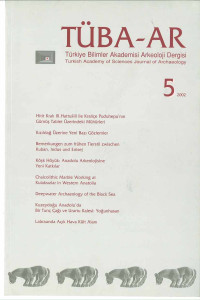Abstract
Labraunda, connected to the ancient city of Mylassa, was a sacred religious center for the Caria region. The remains are situated in the northeast side of the sacred area between and in front of two large rocks that rise approximately 10-15 m height. Among the ruins are several small niches cut into the rocks, one big niche, a door, stairs, a channel for libations. In addition, several sitting places might be mentioned.
The fact that the Labraunda was built into rocks and that the cult area was entered through rocks, links the site with Yazılıkaya, another religious site situated in a naturally rocky environments. The Labraunda cult area, therefore, has many similarities with monuments chiseled into rock façades and those, in particular, built in forest for the Goddess Kybele.
Since the Bronze Age, it is an Anatolian tradition to built monuments and produce reliefs near the natural water sources. Labraunda followed this tradition; it was built on the high rocks near the region's main water source, similar to the sacred area of Eumeneia Kybele in Phrygia. In Labraunda, like the open-air temple of Karahisar, the monuments carved rocks were grouped together to form a religious center
The Labraunda ruins are indicative of an old and native Anatolian tradition. An explanation for the Classic Period's use of the cult area - dedicated to the God Zeus- is the pre-existing veneration of the same space. Carians worshiped their Gods, like the Urartians and the Phrygians, through nature, through water source and natural stone. A door cut into rock, an altar with stairs, and indeed the entire sacred area was constructed to demonstrate the power of the God. The Labraunda cult area represents a synthesis between the Urartian Culture in the East, the Phrygian Culture in the Middle West, and the Ionian Culture along the Aegean. This synthesis is also rep- resented in attributes of statues, such as the Goddess Artemis in Ephesus and on Zeus in Labraunda.
References
- AKURGAL. E., 1995a Hatti ve Hitit Uygartiklar, Net Yayınevi, Istanbul.
Abstract
References
- AKURGAL. E., 1995a Hatti ve Hitit Uygartiklar, Net Yayınevi, Istanbul.
Details
| Primary Language | Turkish |
|---|---|
| Subjects | Archaeological Science, Archaeology (Other) |
| Journal Section | Research Articles |
| Authors | |
| Publication Date | December 15, 2002 |
| Submission Date | July 15, 2002 |
| Published in Issue | Year 2002 Issue: 5 |
Cite
Publisher
Vedat Dalokay Caddesi No: 112 Çankaya 06670 ANKARA
TÜBA-AR Turkish Academy of Sciences Journal of Archaeology (TÜBA-AR) does not officially endorse the views expressed in the articles published in the journal, nor does it guarantee any product or service advertisements that may appear in the print or online versions. The scientific and legal responsibility for the published articles belongs solely to the authors.
Images, figures, tables, and other materials submitted with manuscripts must be original. If previously published, written permission from the copyright holder must be provided for reproduction in both print and online versions. Authors retain the copyright of their works; however, upon publication in the journal, the economic rights and rights of public communication -including adaptation, reproduction, representation, printing, publishing, and distribution rights- are transferred to the Turkish Academy of Sciences (TÜBA), the publisher of the journal. Copyright of all published content (text and visual materials) belongs to the journal in terms of usage and distribution. No payment is made to the authors under the name of copyright or any other title, and no article processing charges are requested. However, the cost of reprints, if requested, is the responsibility of the authors.
In order to promote global open access to scientific knowledge and research, TÜBA allows all content published online (unless otherwise stated) to be freely used by readers, researchers, and institutions. Such use (including linking, downloading, distribution, printing, copying, or reproduction in any medium) is permitted under the Creative Commons Attribution-NonCommercial-NoDerivatives 4.0 International (CC BY-NC-ND 4.0) License, provided that the original work is properly cited, not modified, and not used for commercial purposes. For permission regarding commercial use, please contact the publisher.


